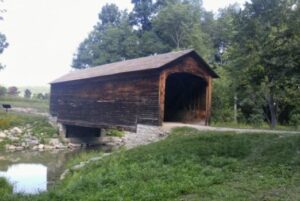
 I’m sure most of us have seen a covered bridge…at least in pictures. Most people think of them as being nostalgic, and I do too. They remind me of times long gone, but why were bridges covered in the first place? It wasn’t to lend a romantic flair to the bridge, you know. No, the real reason for covered bridges actually traces back to what the bridge is made of. Wooden structures then and now are exposed to harsh weather and subject to wear and tear. Covering the bridge does two important things. The cover protects the wooden deck…the surface that people and vehicles travel on. It also protects the truss system, which is the lattice framework under and around the bridge that supports the deck, helping the structure last longer. The roof and side elements were replaceable as long as the support structure remained strong. If the support structure weakens, the bridge will have to be rebuilt, because rotting wood cannot be made strong again. This is one of the main reasons that covered bridges have slowly given way to steel bridges over time. Steel structures hold up years longer than wood.
I’m sure most of us have seen a covered bridge…at least in pictures. Most people think of them as being nostalgic, and I do too. They remind me of times long gone, but why were bridges covered in the first place? It wasn’t to lend a romantic flair to the bridge, you know. No, the real reason for covered bridges actually traces back to what the bridge is made of. Wooden structures then and now are exposed to harsh weather and subject to wear and tear. Covering the bridge does two important things. The cover protects the wooden deck…the surface that people and vehicles travel on. It also protects the truss system, which is the lattice framework under and around the bridge that supports the deck, helping the structure last longer. The roof and side elements were replaceable as long as the support structure remained strong. If the support structure weakens, the bridge will have to be rebuilt, because rotting wood cannot be made strong again. This is one of the main reasons that covered bridges have slowly given way to steel bridges over time. Steel structures hold up years longer than wood.
A covered bridge is a timber-truss bridge with a roof, decking, and siding, so most covered bridges actually look like a building over water. They are an almost complete enclosure, with the exception of their two ends, and sometimes windows. Uncovered wooden bridges typically have a lifespan of only 20 years because of the effects of rain and sun, but when a bridge is covered, it could last over 100 years. In fact, the oldest covered bridge in the United States is Hyde Hall Covered Bridge, which is on the grounds of Glimmerglass State Park in Cooperstown. It was built by George Clarke in 1825 on what was then the private property of Hyde Hall.
Nevertheless, while covered bridges last a long time, in the United States, only about 1 in 10 survived the 20th century. It wasn’t because they were dilapidated, but it was due to deliberate replacement, neglect, and the 
 high cost of restoration. Covered bridges have a long history, and they can be found throughout Europe and especially North America in places like New England, the Mid-Atlantic and the regions around the Great Lakes…mainly because these areas are very wooded, and so the building material there is plentiful. I think it’s rather sad that the covered bridges have almost become extinct…such a loss to history.
high cost of restoration. Covered bridges have a long history, and they can be found throughout Europe and especially North America in places like New England, the Mid-Atlantic and the regions around the Great Lakes…mainly because these areas are very wooded, and so the building material there is plentiful. I think it’s rather sad that the covered bridges have almost become extinct…such a loss to history.


Leave a Reply